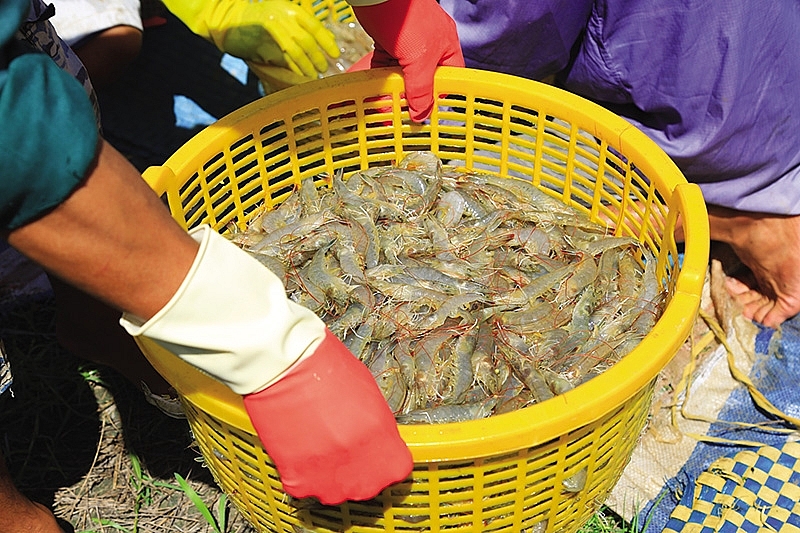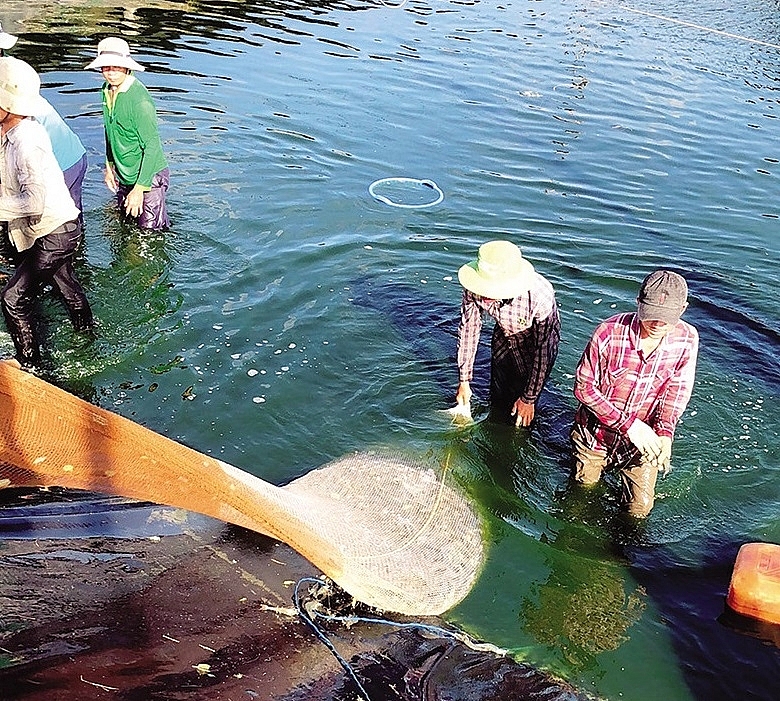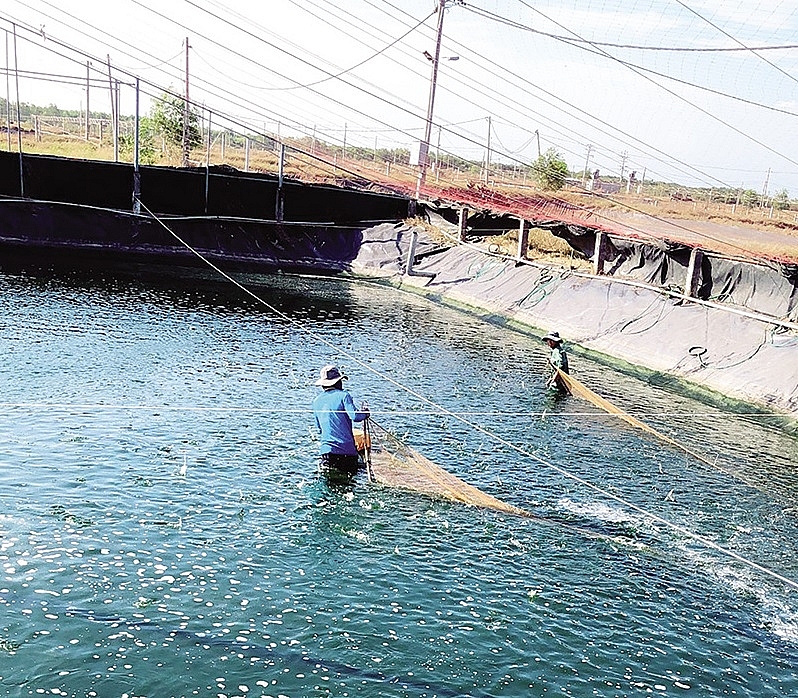Mekong Delta shrimp crops a sweet success
 |
These days, people in Hiep Thanh commune of Duyen Hai district in the Mekong Delta province of Tra Vinh are busy harvesting shrimp.
Hung Vi, a shrimp farm owner, had to ask 20 workers from local shrimp-harvesting teams to help him collecting shrimp from his 1,600 square metre farm. “The total output is about six tonnes. We will catch them all, and then sell to the factory,” Vi shared with VIR.
Pham Thanh Hien, owner of another nearby shrimp farm, has just finished harvesting and is preparing for the new shrimp crop. According to Hien, thanks to new technology and the favourable weather, farmers can now farm shrimp all year round and earn a lot of money.
In An Minh district of Kien Giang province, the model of raising industrial white shrimp in ponds and lakes whose bottoms are covered with linen canvas has been deployed for two years. Le Van Khanh, head of the Agriculture and Rural Development Division of An Minh district said, “With the new model, farmers here can earn profits of VND150-200 million ($6,520-$8,670) per crop per 500-1,200sq.m of lake surface area. They can produce two or three crops per year.”
In An Minh district, there are about 20 households using the model. “We are aiming to increase the area to 100 hectares in 2020,” Khanh said.
Through the introduction of Khanh, we met Nguyen Van Suoi in Van Khanh Dong commune, who has five round lakes to farm shrimp. “After 55 days, one kilogramme collected will contain 80 shrimps and productivity will reach 2.5 tonnes per lake. We earn VND245 million ($10,650).”
Meanwhile, in Bac Lieu, shrimp farmers in Phuoc Long district are also busy with harvesting both shrimp and rice. Le Viet Thang, a farmer in Long Hau commune, shared about the output of his first crop after applying a climate-adaptive smart rice model.
“With this model, we grow rice in shrimp fields. We can save money while getting better rice results, with a yield of around eight tonnes per hectare, which is 10-15 per cent higher than usual.”
According to Thang, after expenses he still earns over VND25 million (over $1,000 per hectare). “In addition to rice and shrimp, we can harvest tiger prawns, sea crabs, and other co-cultured fish in the field. I don’t have to feed or take care of them, but earn nearly VND12 million ($500) per crop,” Thang added.
Citing similar results, Le Hung Cuong, another farmer in the commune, said, “With the model encouraged by the agricultural ministry, we can drop the amount of seed and fertiliser. We can harvest both shrimp and rice with much higher productivity.”
Investing VND1.2 billion ($52,200) in raising shrimp via bio floc technology without using antibiotics since 2011, Minh Nghia, a farmer in Nha Mat commune of Bac Lieu province earns VND2 billion dong (nearly $87,000) each year. Nghia then decided to widen his farm from one to three hectares.
“Every three months, we will harvest shrimp at a size of 40 per kg and sold at VND260,000 per kg ($11.30), higher than the price of traditional shrimp. Thanks to the fast growth of shrimp and good disease control, we can farm four crops per year,” Nghia said.
 |
 |
| Utilising new models farmers can now grow rice in shrimp fields, saving money and becoming more efficient |
Abundant supply
As a second-level agent operating since 2010 in Tra Vinh, agent Hong Dan has over 2,000 households providing shrimp. “Each household has about four hectares, and together they provide me with about 10,000 tonnes of shrimp each year,” Dan said.
Each day Dan directly buys about 25 tonnes of white shrimp from farmers. “These days, we work continuously. Each day, I have to spend VND2-3 billion ($87,000-$130,400) buying shrimp, farmers get the money, then we take the shrimp immediately to first-level agents,” Dan added.
Meanwhile, Phan Van Be, director of first-level agent Thanh Tan Company in Tra Vinh, said that currently he has about 20 second-level agents providing him a stable amount of shrimp. “We have abundant input from the provinces of Tra Vinh, Soc Trang, and Ben Tre and every month our agents collect from 2,000 to 2,500 tonnes.”
According to Be, all of it will be supplied to Minh Phu Group, one of the biggest shrimp producers and exporters in Vietnam. “Currently, our company’s supplies only account for a small portion of Minh Phu’s purchases. Together with us, Minh Phu also receives supplies from tens of first-level agents which, in turn, have hundreds of second-level agents and farms that provide shrimp to the group,” Be said. “Only from our area, Minh Phu normally purchases 30 to 40 ponds worth of shrimp a day,” Be added.
Also providing shrimp to Minh Phu, Le Thi Cam Loan, another first-level agent in Duy Hai commune of Tra Vinh said, “I have been supplying shrimp to Minh Phu for the last ten years. Almost all households farming shrimp here sell their products to the group.”
According to Loan, she feels completely satisfied with the way that Minh Phu works with agents and farmers.
“We all have long-term agreements with Minh Phu for joining its supply chain programmes that help farms in our networks improving their productivity and quality. Minh Phu has introduced technologies, trained our farmers and guaranteed to buy our shrimp at better market prices. When we inform that the shrimp pond can be harvested, Minh Phu will send staff to test the antibiotics residue, and quickly inform us about the results and the price. Soon after that, we get the payment.”
Sharing with VIR about this way of working, Le Thi Thuy, deputy director in charge of materials of Minh Phu, said that the group always notices the role of farmers and agents. “When we build trust and good co-operation with them, we will get good products, and they will help us grow further.”
According to Thuy, Minh Phu has two factories with capacity of 300,000 tonnes per day. Thanks to the large raw shrimp supplies in the Mekong Delta region such as Tra Vinh, Ben Tre, and Soc Trang, Minh Phu is confident that it will have sufficient raw shrimp to meet with orders from its overseas and local customers.
“Besides, we also farm shrimp by ourselves. We have been farming shrimps for over 10 years and heavily invested in developing shrimp farms that will be reaching 2,000ha this year so that Minh Phu can be more in control of its raw shrimp supplies,” Thuy said.
Starting from 2017, Minh Phu’s shrimp farms have implemented the “234” technology, with a success rate of almost 100 per cent. “The 234 technology means two raising stages, three trimming times, and four cleans,” Thuy explained.
Telling VIR about the results, Le Van Quang, chairman of Minh Phu, said, “I myself have devoted a lot of time to work with our technical team and experts from all over the world to study, develop, and experiment with this technology and I was stunned by the results. I think hygiene to avoid disease and cleanliness in water sources, antibiotics, and environment will help increase productivity and quality in shrimp farming. We will share this with thousands of farmers in the areas that have been supplying us with shrimp for years.”
According to Quang, the 234 technique is applied on 8ha of Minh Phu farms, including 20 floating ponds with a diameter of 32m (equivalent to 1,000sq.m per pond) and 10 floating ponds with a diameter of over 17m.
“We are still working on further improvements in order to get better results. The target is that our own farms will supply at least 50 per cent of our raw material needs for production while we hope that with the application of the new technology, local farmers who have joined our supply chain will be able to supply the rest of our raw shrimp demand very soon,” Quang said.
Additionally, Quang affirmed that Minh Phu pays particular attention to innovating technology which creates more value-added goods, increases competition, and meets the market demand for the benefits of all sides.
With the support of technologies and good co-operation between enterprises and farmers, Vietnam’s shrimp-producing industry is developing with bigger quantities and better quality, ultimately bringing more income for both local farmers and businesses.
What the stars mean:
★ Poor ★ ★ Promising ★★★ Good ★★★★ Very good ★★★★★ Exceptional
Related Contents
Latest News
More News
- Businesses ramp up production as year-end orders surge (December 30, 2025 | 10:05)
- Vietjet chairwoman awarded Labour Hero title (December 29, 2025 | 13:06)
- How to unlock ESG value through green innovation (December 29, 2025 | 10:03)
- AI reshapes media and advertising industry (December 29, 2025 | 08:33)
- FPT and GELEX sign deal to develop blockchain tech for global markets (December 29, 2025 | 08:29)
- Vietnam’s GDP forecast to grow by 9 per cent in 2026 (December 29, 2025 | 08:29)
- Women entrepreneurs are key to Vietnam’s economic growth (December 29, 2025 | 08:00)
- Vietnam's top 500 value-creating enterprises announced (December 27, 2025 | 08:00)
- The PAN Group shaping a better future with ESG strategy (December 26, 2025 | 09:00)
- Masan Consumer officially lists on HSX, marking the next phase of value creation (December 25, 2025 | 13:20)

 Tag:
Tag:





















 Mobile Version
Mobile Version